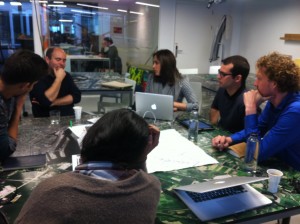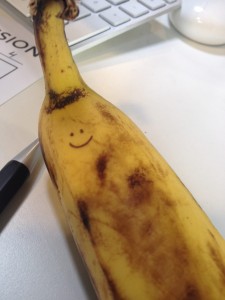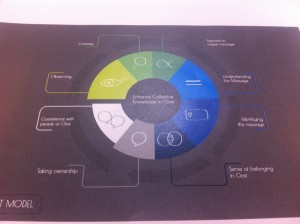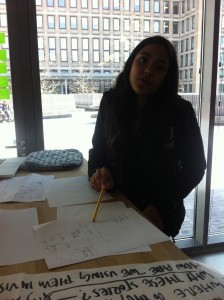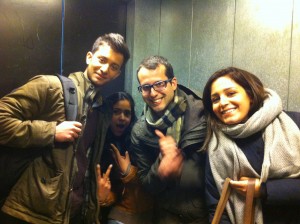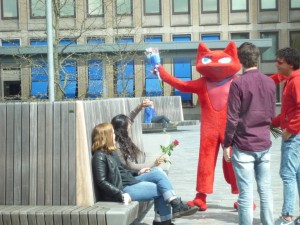It’s been a rollercoaster of a week. We’ve tested our visuals, had our translate session, went to a serious slew of meetings and edited some of our work from last week. Whew. We’ve also been dealing with a slightly-paralyzing-and-completely-anxiety-provoking feeling that we just haven’t got a lot of time left before our very final presentation. Breathe. In. Out. In. Out.
One of the first tasks we set out to do this week was to test our prototype. We headed to the Volkshotel on Tuesday to Role Play (it’s a method people) in order to gain some design insights. It was the first version of our visuals that Lisanne had added colour to, so it was interesting to see how, well… yellow everything looked. Oops. Beyond realizing certain things from a visual perspective, we added another task to our mile-long to do list: buy a splitter (so we can display different visuals on the different projectors in the space).
On Wednesday we had our Translate Session, which was set up a bit differently this Sprint. Instead of creating a digital presentation we filled out a form, which basically linked our user stories to our methods to our insights. It was a simple, effective way to explain what we had been up to in the past week. It made the entire session a lot more informal, and we were able to have a real back-and-forth discussion about our work with Tamara, Gijs, Mariska and the Intelligent Environment team. We mostly talked about technical issues we’ve been having (such as the amount and relevancy of our data sources) which was a belangrijke thing to do, for sure.
We met with Martijn de Waal on Thursday morning, who is an expert in the field of engagement as it relates to the urban sphere (and the author of Atossa and Orlando’s all-time fav, “The City as Interface” – read: they were a bit star struck). He not only showed us spectacular projects to inspire us, but also brought up key elements of our project (such as the “Landing Zone”, the physical area where people have discussions about a screen) that we hadn’t thought about before. We realized that we need our visuals to be more provocative and playful in order to encourage users to be, well, interested. It was a brilliant meeting and we all felt a tad enlightened afterwards.
After that meeting, we had a chat with Gijs about what we had learned from Martijn, and started to think about potential user stories for our next sprint. #Onit. We’ve pinned down a couple of ideas that we want to start working towards, which is fantastic because the month of May is riddled with holidays so all of our ensuing Sprints will be cut short. Sigh.
One of the insights from the Translate session and our meeting with Martijn was to edit our engagement model a bit. So, Atossa added new elements such as “exposing users to a vague message” and having users “identify with the message”. Man, this girl is good. The next step in fleshing out the model is to make it quantifiable, so that we can measure our user’s activity through the model. What a time.
We also received feedback to improve upon our technical flow chart, which Shreya and Nikhil have been working on. We introduced a more comprehensive framework to represent data flow through data processing and visualization modules (as some components were left out in our previous version). We’ve got to make it clear enough for all of the very un-tech-saavy people out there, which is tricky but these guys have got it.
On Friday we went to meet with Northern Light, the fantastic company behind the OBA Linnaeusstraat building. It was a bit of a journey to get there (read: we walked around Noord for about 45 minutes slightly willy-nilly) but it was totally worthwhile. The studio space itself was lovely, and the people we met, even more so. We got to understand what they had originally intended for the space (to have it be sort of like a pop-up cultural center), and what they think the screen should be used for. It was heel leuk.
Now we’re on to a four day weekend (really, the month of May is #doingitright) and we’re feeling something along the lines of this. Tot ziens!











